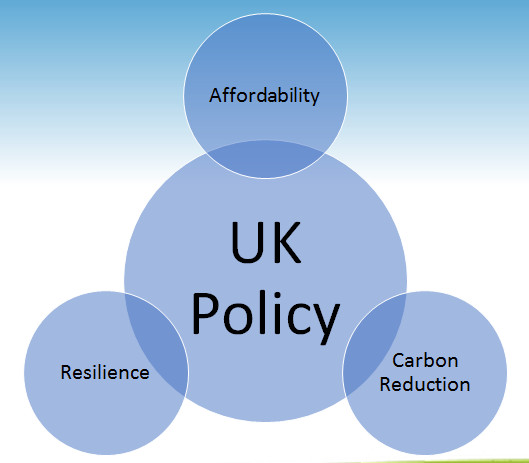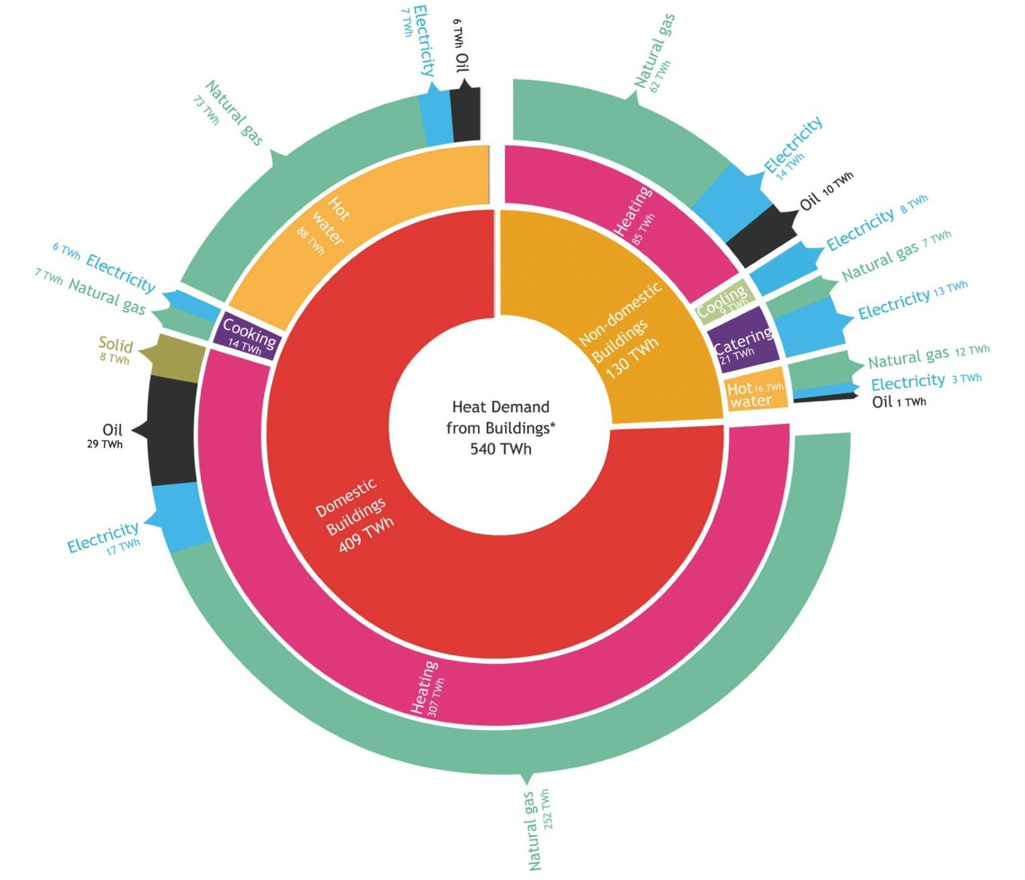The Decarbonisation of Heat
Heat Storage
and Heat Sharing Networks
Government is concentrating on how to decarbonise and secure our heating and cooling infrastructure in an affordable way. The three-way demands of affordability, resilience and carbon reduction have equal weight but for very different reasons.
The decarbonisation of heat has been a watchword since the passing into UK law of the European Directive on carbon emissions reduction. This has been strengthened by the UK's own fourth and fifth Carbon Budgets reaching out to 2032. There is a cross-party consensus that we must not only reduce carbon emissions, but also lead the way in attempting to control the inexorable rise in global temperatures.
Heating and hot water dominate the energy demand in buildings in the UK, partly because of the age of UK period housing stock when compared to the rest of Europe – 32% of UK emissions are derived from the heating of buildings.
With North Sea fossil fuel reserves under pressure from global policy and from increased recovery costs, the UK is now a net importer of fuel for heating. There have been times when UK gas stocks have hit dangerously low levels during winter with holdings down to a few days. Add to this the increased levels of geopolitical uncertainty with much of our imported natural gas sourced from unstable regions and it is clear that resilience needs to be a priority.
However, these two powerful drivers need to be tempered with affordability. Heat poverty in the UK is on the increase. The price of fossil fuels continues to rise, especially for those on oil in rural communities. The recently published Clean Growth Strategy aims to "Phase out the installation of high carbon forms of fossil fuel heating in new and existing businesses off the gas grid during the 2020s, starting with new build" and to "Phase out the installation of high carbon fossil fuel heating in new and existing homes currently off the gas grid during the 2020s, starting with new homes".
This will require the replacement of oil heating with something less carbon intensive. Ground source heat pumps can resolve these three conflicting pillars of policy.
District Heating Networks
District heating networks are one of the many hot topics in the policy world. The weaknesses of conventional high temperature gas-based district heat networks are both technical and financial. The high cost of heavily insulated pipework, the heat losses and the complex contracts required to own and operate them can be insurmountable. Also, the high temperatures required to feed the networks limit both the heating technologies and heat recovery opportunities available.
Heat Sharing Networks
One option which overcomes these problems is the adoption of ambient ground temperature district networks; ranging from micro networks serving just two homes up to the very large scale. In these systems, buildings share a network of uninsulated pipes with water circulating at ambient ground temperature. This avoids the need for expensive insulated pipework in conventional district networks. A high degree of independent control can be provided by using heat pumps in individual buildings for both heating and cooling. Further benefit which can be incorporated through interseasonal energy storage and heat recovery.
By extending the ambient temperature network to include a larger ground collector, we can enhance both heating and cooling efficiencies for all the connected buildings. These collectors come in many forms, from closed loops within boreholes to water wells and even interactions with surface water bodies such as rivers, lakes, canals or the sea.
These long-term assets can serve not only the current but also future generations of buildings, much like the gas, water and electricity networks do today.
UK winters have relatively benign temperatures with high rainfall and high humidity. These favour GSHPs over all other renewable heat technologies. The electricity grid is rapidly being decarbonised as successful UK generation policy has driven investment in on-shore and off-shore wind and in solar photovoltaics.
Decarbonisation of the Grid
Taking data from DEFRA, the carbon grid factor (the amount of CO2 emitted per unit of electricity) reduced by 29% between 2014 and 2017. This reflects the reduction in coal fired generation, an increase in gas-fired capacity and a major increase in renewable electricity generation from wind and solar. In the second quarter of 2017, wind, solar and hydroelectric power were responsible for 30% of the total UK electricity generation, beating the previous record of 27% set just three months earlier.
At current levels, GSHP systems operating with a typical Seasonal Performance Factor of 3.2, are already more carbon efficient than a gas-fired boiler, offering reductions in CO2 equivalent emissions of some 40%. Welcome requirements to build well insulated housing has created a new demand for modest levels of cooling, particularly in urban developments. Here again, ground source has a unique ability to deliver a low carbon solution, offering passive cooling for just the cost of running a circulation pump.
Ground as a long term asset
The fuel security long provided by the North Sea is being eroded. However, there is another natural asset which we are not yet exploiting as we should. Our land and surface water need to be considered as a thermal battery, where the sun is the charger. Ground source heat pumps harvest genuine renewable solar energy stored as heat. If sustainably extracted, this resource is effectively infinite. Ground source energy can bring a significant proportion of UK heat energy demands back on-shore with very obvious benefits.
In terms of longevity, GSHP systems also have the upper hand. A typical gas power station might be expected to operate for 30 to 40 years, provided it has an economic source of gas to burn. The renewable "fuel" source for a GSHP is, of course, the sun via heat storage in the ground. One option to access this source of heat is to drill closed-loop boreholes to a depth and design suited to the geology and building in question. The borehole infrastructure has a life expectancy of over 100 years.
This longevity can provide the affordability that all governments demand. It is essential that the "in-ground" asset is recognised as a very long term asset, and that it should be valued in a similar way to the investments that are made in water, electricity and gas infrastructure. These are all recognised as investing in the future and drilling ground source boreholes should be seen in the same light.
Demand Side Response
A common concern around the increased deployment of GSHPs is the added pressure on the national grid. However, the electrification of heat is coming, of this there is no doubt. The generators and distribution network operators (DNOs) need to embrace heat pump technology rather than view it as something to be feared. A heat pump seasonal performance factor of 3-4:1 compares very favourably with the 1:1 ratio of direct electric heating.
In addition, large scale deployment of heat pumps gives generators and DNOs opportunities for demand side management that have not yet been extensively exploited. Innovative integration between renewable electricity generation, electrical battery storage and ground battery storage will deliver the ability to "flatten" out grid demand in a way that no other technological combinations can.
Meeting policy demands
To address the government's central three-pronged policy demands, GSHP infrastructure can:
- contribute significantly to the decarbonisation of heat and cooling
- dramatically reduce the potential impact on the national grid and on generation resources when compared to resistive heat (SAP implications)
- control operational costs for those in fuel poverty, especially when displacing direct electric, oil or LPG
- contribute to national fuel security by bringing the resources on shore (as opposed to importing gas)
- contribute to the national balance of payments by displacing imported fuels
- provide high quality employment in a growing market with on-going maintenance requirements requiring high skill levels and so providing excellent job opportunities
- displace investment in fossil-fuel generation capacity with longer term value given the accepted design life of installed ground source infrastructure when compared to the equivalent for gas-fired power stations.
For large commercial entities, ground source systems can contribute to satisfying CRC and ESOS reporting requirements.
For local authorities, social housing landlords, developers and the major house-builders, GSHP systems open-up significant opportunities for genuine, low temperature heat networks. Depending upon configuration, these can reduce transmission losses to zero when compared to the traditional fossil-fuel and centralised plant schemes of the past.
Renewable Heat Incentive
Financial motivation for investment in ground source is provided by the Renewable Heat Incentive. The RHI pays for each kilowatt of heat delivered to a building by a GSHP over twenty years and is CPI index linked. The simple payback periods for this type of investment are short and, even allowing for project funding at current commercial rates, projects can turn to profit well within a ten-year window and go on to more than double the initial investment by year twenty.
The RHI is set to run until 2021 for new entrants. Policy development is now looking at what will be required to keep investment levels in ground source on an upward trajectory from 2021 to contribute to delivery on the Carbon Budgets.
Many mainstream mechanical consultants are new to this type of infrastructure, which can limit their thinking to the building rather than to the energy source. The UK ground source industry is packed with experience and expertise. Underpinning the design and installation of GSHP systems are landmark Standards from CIBSE and the Ground Source Heat Pump Association which set out clear procurement guidance via specialist contractors and consultants.
Ground source energy has long been the Cinderella of low carbon heating in the UK. The clock of carbon-emission-derived climate change has long since struck midnight, but ground source is still waiting for the Prince Charming of government to come along with a policy that fits so that it can take its rightful place at the top table.
Despite making the right noises, Westminster has persisted in treating all renewable heat technologies as if they were the same. This fails to recognise the many unique attributes that GSHPs bring to the party. All that is now required to unlock this huge potential is a future "slipper" of policy that fits.



